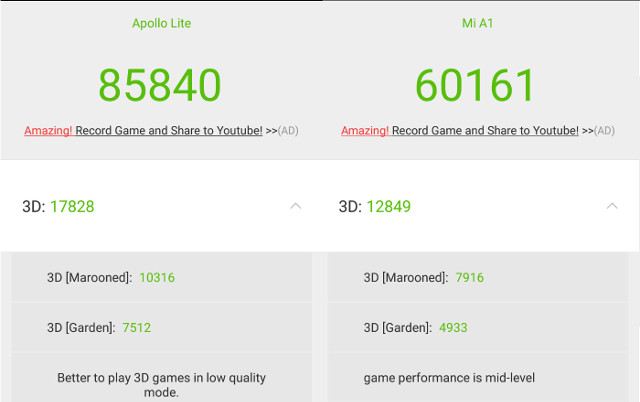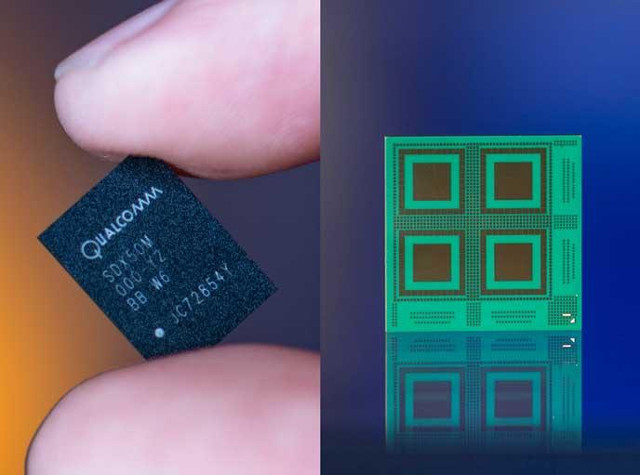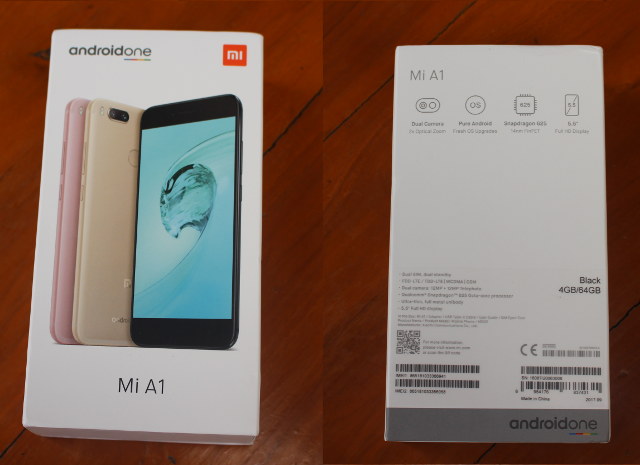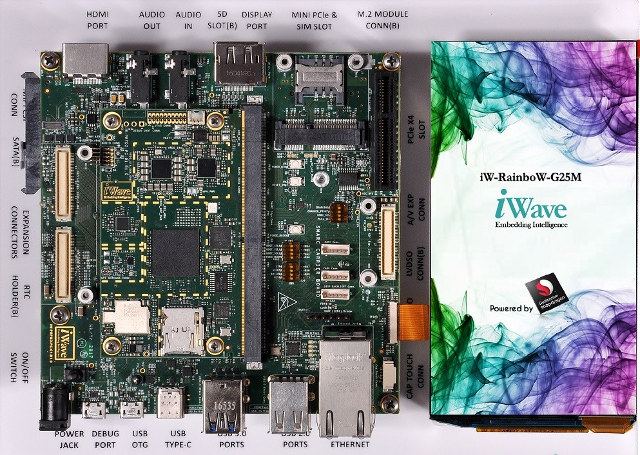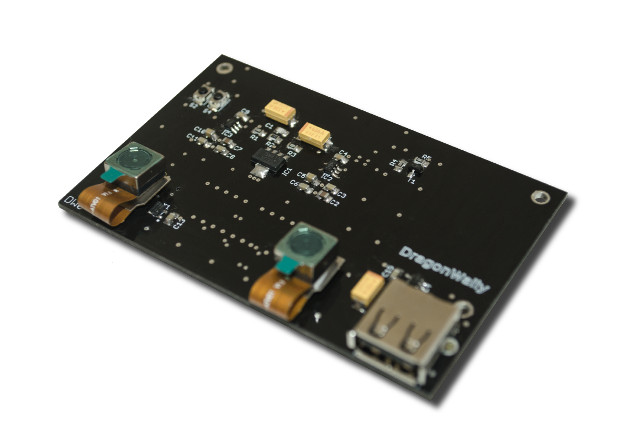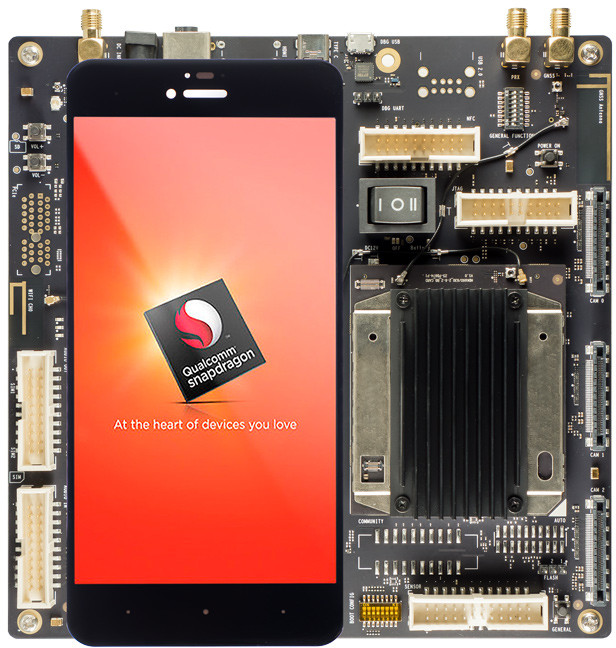I’ve been using Vernee Apollo Lite smartphone with a Mediatek Helio X20 deca-core ARM Cortex A72/A53 processor coupled with an ARM for a little over a year. Recently, I’ve received Xiaomi Mi A1 smartphone for a Qualcomm Snapdragon 625 SoC featuring eight ARM Cortex A53 cores and an Adreno 506 GPU. In theory, the latter is a downgrade, and the Xiaomi phone is indeed quite slower in Antutu with overall score of 60,161 points against 85,840 points in the Mediatek phone. 3D graphics performance is also lower with 12,849 vs 17,828 points. Both smartphone have the same resolution (1920×1080), so it’s a little confusing to be told you’d “better to play games in low quality mode” for the Mediatek phone, and “game performance is mid-level” for the Snapdragon one. But anyway Helio 20 should work better in 3D games than Snapdragon 625 if we are to believe the numbers. Most […]
Snapdragon X50 5G Modem Makes it First Data Connection
5G technology is expected to launch in 2019, and Qualcomm has recently made a step towards this goal with the company announcing their first 5G data connection with Snapdragon X50 modem on on 28GHz mmWave Spectrum. The demonstration took place in Qualcomm Technologies’ laboratories in San Diego, and achieved Gigabit download speeds using several 100 MHz 5G carriers. Snapdragon X50 5G Modem’s product page lists some of the key features of the chip: Up to 5 gigabits per second download speeds Initial support for operation in the 28 GHz millimeter wave band. It can connect using up to 800 MHz of bandwidth via 8×100 MHz carrier aggregation. Supports advanced multiple input, multiple output (MIMO) techniques such as adaptive beamforming and beam tracking Composed of the modem as well as the SDR051 mmWave transceiver The modem can be paired with a Snapdragon processor to provide multi-mode 4G/5G capability, and the company […]
Xiaomi Mi A1 Review – Part 1: Unboxing, First Boot, Firmware Update, and Benchmarks
Xiaomi Mi A1 hardware specifications are pretty much standard for a mid-range smartphone, except possibly for its dual rear camera, and what makes it stand apart is really Android One program that promises regular firmware update, including to the latest “pure” Android version, during a 2-year period from launch. In my case, the phone is also interesting because so far I had only used smartphones with Mediatek SoCs, and Mi A1 is equipped with a Qualcomm Snapdragon 625 processor. SD625 should be slower than the Mediatek Helio X20 deca-core processor I’ve been using in Vernee Apollo Lite, but I’m curious to find out if some apps have been better optimized for Qualcomm processors. I’ll soon find out as GearBest sent me a review sample.I’ll start with an unboxing and first boot post, before writing the second part of the review in a couple of weeks once I’ve finished testing the […]
iWave Systems iW-RainboW-G25D is a SMARC 2.0 Compliant Snapdragon 820 Development Kit
iWave Systems previously launched iW-RainboW-G25S single board board powered by Qualcomm Snapdragon 820 processor. The company is now back with a new Snapdragon 820 development kit called iW-RainboW-G25D that complies with SMARC 2.0 SoM specifications. The kit include a SoM with 3GB RAM, 32GB storage, WiFi and Bluetooth connected to a SMARC compliant baseboard, and optionally features a 5.5″ AMOLED touch screen display. iWave Systems iW-RainboW-G25D development kit specifications: APQ8096 SMARC iW-RainboW-G25M SoM: SoC – Qualcomm Snapdragon 820 (APQ8096) quad core Kryo CPU with Adreno 530 GPU @ 624MHz, Hexagon 680 DSP @ 825 MHz (no modem) System Memory – 3GB LPDDR4 RAM Storage – 32GB eMMC Flash, micro SD slot Connectivity PCIe to Gigabit Ethernet + PHY 802.11a/b/g/n/ac Wi-Fi + BT4.1 Low Energy (BLE) GPS/GNSS receiver 314-pin MXM 3.0 edge connector as per SMARC 2.0 specifications SMARC Carrier Board Storage – M.2 slot (back), SATA, SD card slot (back), […]
Dragonwally is a Stereoscopic Computer Vision Mezzanine for 96Boards CE Boards
Hardware based on 96Boards specifications may not have the number of sales as Raspberry Pi or Orange Pi boards, but there’s heavily used by Linaro member and other developer working on bleeding edge software. More and more companies are designing boards compliant with the standard, and several new mezzanine expansion boards such as Secure96, were showcased at Linaro Connect SFO 2017, and are yet to be show up on 96Boards Mezzanine page. Another 96Boards mezzanine expansion board in development is Dragonwally, designed for stereoscopic computer vision, currently used with DragonBoard 410c board, and targetting applications such as object recognition, people counting, access control, or driver identification and safety. DragonWally DW0 board specifications: MIPI DSI interface with high speed connector 2x 5MP cameras 1x USB port 96Boards CE compliant The two Brazilian developers working on the project interfaced it with DragonBoard 410c running Linaro Debian, and using OpenCV and Python for […]
Intrinsyc Launches Open-Q 660 HDK Snapdragon 660 Development Kit
For many years now, Intrinsyc has been releasing Qualcomm mobile development platforms that that are used by companies wanting to design and manufacture smartphones or other products based on Snapdragon processors. Those are usually full featured, including a smartphone display, and well suited to such product development. Their latest development kit is the Open-Q 600 HDK (Hardware Development Kit) powered by Qualcomm Snapdragon 660 SoC, an upgrade to Snapdragon 653 with about 20 percent improvement in CPU performance, and 30 percent in GPU performance. The kit is also equipped with 6GB RAM, 64GB flash, a display, wireless modules, sensors, camera interfaces, expansion headers, and more. Intrinsyc Open-Q 600 specifications: SoC – Qualcomm Snapdragon 660 octa-core processor with Four Kryo 260 performance cores @ up to 2.2GHz, four Kryo 260 low power cores @ up to 1.8GHz Adreno 512 GPU @ up to 650 MHz supporting OpenGL ES 3.0/3.2, Vulkan, DX12 FL […]
Google Introduces Pixel 2 and Pixel 2 XL Smartphones running Android 8.0 on Snapdragon 835 SoC
When Google introduced Nexus brand, it aimed to provide affordable yet decently spec’d Android smartphone. The Nexus has now been deprecated, Google left the low/mid range market, leaving other fills the void, and instead launch the Pixel brand for premium devices. The company announced several new hardware devices yesterday, including two new Pixel smartphones: Pixel 2 and Pixel 2 XL, both powered by a Qualcomm Snapdragon 835 processor, and running the latest Android 8.0 Oreo. Both phones share most of the same specifications: SoC – Qualcomm Snapdragon 835 with 4x Kryo 280 “performance” cores @ 2.35GHz, 4x Kryo 280 “efficiency” cores @ 1.90GHz, Adreno 540 GPU, security module System Memory – 4GB LPDDR4x Storage – 64GB or 128GB flash Display Pixel 2 – 5.0″ always-on AMOLED display with 1920×1080 resolution (16:9 aspect ratio); 2.5D Corning Gorilla Glass 5 Pixel 2 XL – 6.0″ always-on pOLED display with 2880×1440 resolution (18:9 […]
MACCHIATOBin based DIY ARM Desktop, DragonBoard 820c based DIY ARM Laptop (Video)
2017 may be the year of the (ARM based) Linux desktop, sort of. We’ve already seen GIGABYTE ARM development PC powered by a Socionext SC2A11 Synquacer 24-core ARM Cortex A53 processor that will be available in December, and apparently working fairly well already. But there are even more options, as Bernhard Rosenkränzer (Bero) from the Linaro Mobile Group, and unofficial Linaro superstar, has decided to create his own ARM based desktop and laptop, based on respectively MACCHIATOBin board with a Marvell ARMADA 8040 quad core Cortex A72 processor, and DragonBoard 820c board with a Qualcomm Snapdragon 820 quad core Krait processor. Since MACCHIATOBin board complies with mini-ITX form factor, he could simply use off the shelf parts with a standard desktop case with power supply, NVIDIA or AMD Radeon graphics card, 16GB memory modules, and a 2 TB SSD drive. The AMD Radeon card fried due to overheating, so the […]


